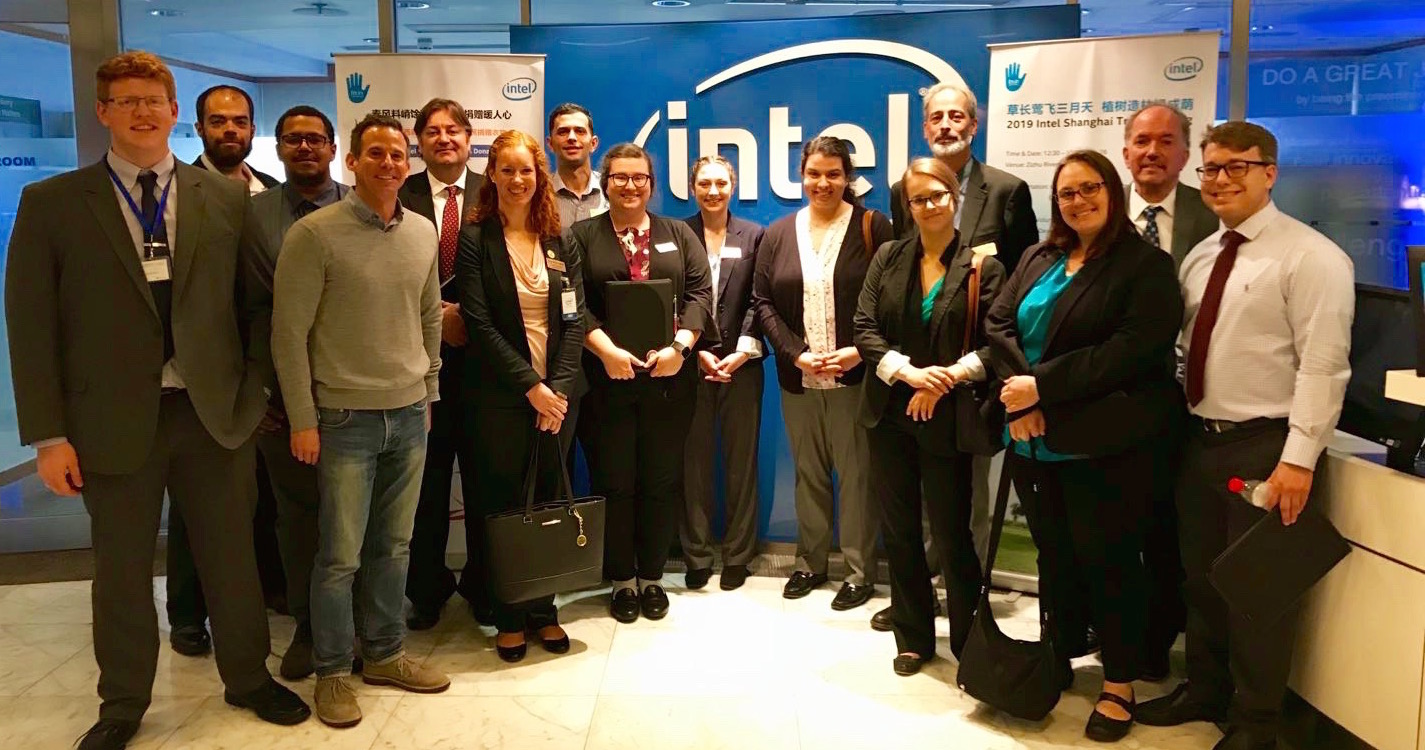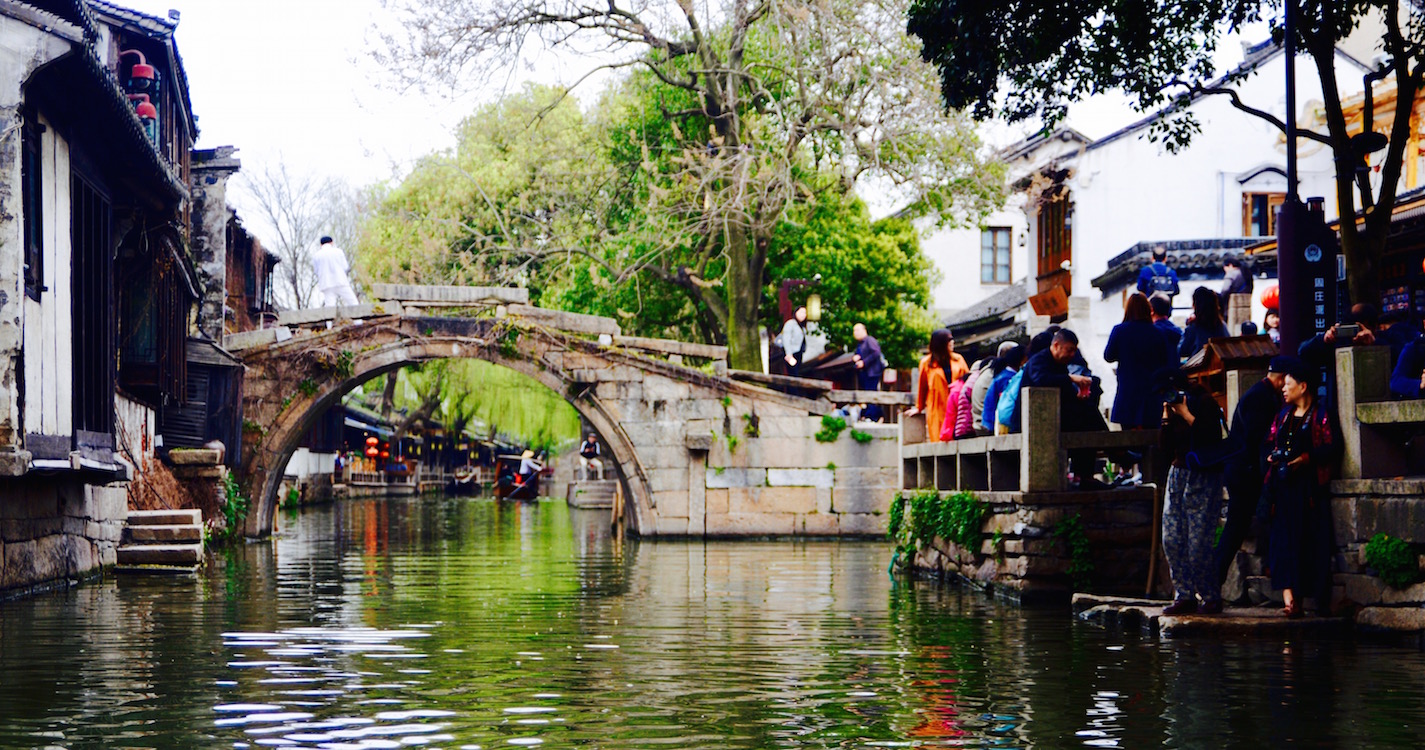We were received in Shanghai's modern railway station by Zoe, our guide during our stay in the city. Zoe was fashionable, high-energy, and greeted us every morning with, "Does everybody feel 'ding ding hao'"? Apparently this is the Shanghainese dialect for feeling very good.
Shanghai is a younger city than Beijing and has a more international outlook. It had humble beginnings as a fishing village but has grown to be the second most populous city in the world. This happened rather quickly: the population was only 5.93 million in 1980; it's now up to over 24 million in the urban area. The entire Pudong district was farmland 15 years ago, but it now showcases the second-tallest building in the world, the Shanghai Tower. The photo I've included from the observation deck captures the city's history in a succinct way, including the rapidly developed Pudong district in the foreground and the early 20th century British architecture in the background. That area is known as the Bund, which served as the financial center during colonial British rule.
Visiting Intel Shanghai
Our first full day in Shanghai began with a visit to one of Intel's two Shanghai facilities. Our host Lex ran us through Intel's company-wide strategy to provide context for his presentation on the company's China operations. Intel is currently expanding beyond the PC chip market--its core business for the last four decades--to high-growth areas such as mobile communications, the internet of things, programmable chips, and data center hardware. In 2014 Intel's data center group contributed to 25.8% of company revenue and grew to 32% in 2018. That shift demonstrates Intel's new strategic focus in financial terms.
What exactly is Intel doing in China? They opened their first Chinese office in Beijing in 1986, eight years after Deng Xiaoping began economic and foreign policy reforms to open up the country. They now have a network of manufacturing, test & assembly, research & development, and sales & marketing in five major Chinese cities: Beijing, Chengdu, Dalian, Shanghai, and Shenzhen.
Talking casually with Lex as we looked out over the Shanghai skyline provided some insight into what it would be like to live and work in Shanghai. He expressed his appreciation for his international group of friends, the things he learns from interacting with diverse people regularly, and the fun of living in such a dynamic, fast-paced city. Plus, he had a lot of flexibility in creating his role when he came to China from the U.S.
I certainly felt some of that energy during our visit. Every neighborhood I visited in Shanghai felt unique. Some areas felt like LA with high-end shopping and trendy restaurants, others reminded me of Buenos Aires' tree-lined streets and European-style architecture. But after entering a park I was reminded that this is China, not Europe. It's common to find groups of people practicing tai chi or playing with a tsa lin, a spinning top that people crack with a whip to keep it upright. Shanghai seems like a fascinating confluence of cultures, representative of its history as a colony and major international trade center.
Visiting Omnicom Media Group
Our day continued with a visit to Professor Gary Knight's former student, Samantha Jahnke, now Head of Digital at OMD China. OMD is a major marketing agency renowned for its creative media communications. Here our conversation focused on branding. It was particularly interesting to learn that China essentially skipped using credit cards to make purchases, jumping forward to mobile payments instead. My understanding is that you can nearly do away with cash in today's China, using the WeChat or AliPay apps instead to pay for taxis, restaurant bills, the metro, or even tip a street performer. One other thing our host noted was that consumer confidence was gaining for Chinese brands, a shift from the common, past perception that foreign brands were generally higher quality. This shift has had a great effect on foreign brands in China, especially those that sell direct to consumers.
From backyard furnaces to the world’s largest steel producer
After OMD we made a short drive to Baosteel's massive complex on the edge of the Yangtze River. It was fascinating to see gigantic hunks of red-hot steel move rapidly through a process that flattened it, cooled it with water, and rolled it into massive coils. Most of this process has been automated: only 3-4 people were in the massive factory producing many tons of steel per day. China's steel industry has come a long way from the late 50's to early 60's when farmers were fabricating steel in their backyards. China is now the world's largest producer, user, and importer of steel on the planet.
Becton Dickinson Rapid Diagnostics: operations management in the real world
Our final trek was to Suzhou, roughly two hours from Shanghai and not a small city itself with a population of 10.58 million people. Shanghai's smaller city to the west has more people living in it than New York City. Here we visited Becton Dickinson Rapid Diagnostics, where our hosts graciously presented us information about the company and gave us a tour of their manufacturing facility. Here we were able to see in action some of the concepts we have learned about in our operations management class: kaizen models that reward production line workers for making processes more efficient and statistical process control data monitoring the number of defects per units manufactured.
Touristy outings
We capped the trip off with two touristy outings: a river cruise along the Bund and Pudong districts to observe the architecture illuminated at night, and both a walking and canal boat tour of the Suzhou "water city", a city built on canals dating back to before 400 BCE. I'm really grateful for the opportunity to see both of those unique sights in China: one clearly displaying Shanghai's colonial history and modern development, the other a beautiful example of an imperial Chinese city.
Reflecting back on the questions I initially asked myself before leaving, I believe I have some insight now.
- What tangible artifacts exist in China due to their industrial boom? Artifacts of industrialization are everywhere in Beijing and Shanghai. Shanghai's Pudong district transformed from farmland into a district of modern skyscrapers, including the second-tallest in the world. Foreign brands such as Starbucks, KFC, and many more Chinese brands I am not familiar with are abundant in the cities. Cell phone use and mobile payment systems are so common now that Chinese netizens must view cash as an inconvenience.
- How has life changed for the average Chinese citizen in the last 29 years? One thing I noticed were brand new housing developments that typically included from 8 to 12 tall, identical apartment towers. Some were much larger than that and they are everywhere in the cities and outlying areas. I understand this to be the way China has accommodated roughly 600 million new urban residents since 1978. I perceive that to be the most significant change for the average Chinese person in the last forty years: a shift from agrarian to urban life, with all of the modernity China has developed in that same time frame.
- What's it like to be a foreigner living and working in China? I gleaned some insight into this during my conversation with Lex at Intel, though it's important to acknowledge the uniqueness of each individual's experience. I felt pretty comfortable in both Beijing and Shanghai, though surely aware of the fact that I was a foreigner. I was greeted with a mixture of suspicious eyes, smiles, genuine interest, and at times unbounded enthusiasm that a foreigner was interested in Chinese culture. I will explore this question further during my semester in Shenzhen next fall.



